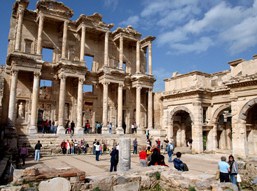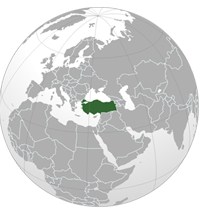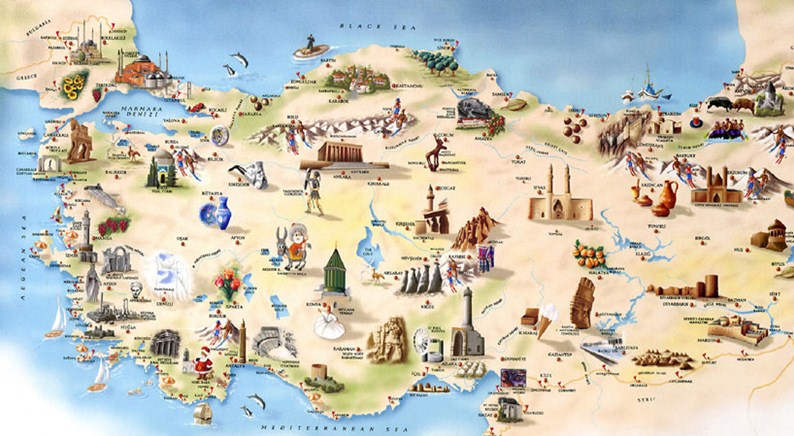ABOUT TURKEY
HISTORY
 Turkey
has been called "the cradle of civilization" and by travelling through this historic
land, tourists will discover exactly what is meant by this phrase. The world's first
town, a Neolithic city at Catalhoyuk, dates back to 6,500 B.C. From the days of
Catalhoyuk up to the present, Turkey boasts a rich culture that through the centuries
has made a lasting impression on modern civilization. The heir to many centuries
of cultures makes Turkey a paradise of information and cultural wealth. Hatties,
Hittitess, Phrygians, Urartians, Lycians, Lydians, Ionians, Persians, Macedonians,
Romans, Byzantines, Seljuks, and Ottomans have all made important contributions
to Turkish history, and ancient sites and ruins scattered throughout the country
give proof of each civilization's unique distinction. Turkey also has a very fascinating
recent history. Upon the decline of the Ottoman Empire, a young man named Mustafa
Kemal, who was a solider by occupation but in character, a great visionary, took
the defeat of World War I and turned it into a shining victory by liberating Turkey
of all foreign invaders. Mustafa Kemal Ataturk founded the Republic of Turkey on
October 29, 1923. He led his country into peace and stability, with tremendous economic
growth and complete modernization. Through decades of change and growth, Turkey
till boasts this success, living by its adopted motto of "Peace at Home, Peace in
the World". The Capital city of Turkey, is Ankara.
Turkey
has been called "the cradle of civilization" and by travelling through this historic
land, tourists will discover exactly what is meant by this phrase. The world's first
town, a Neolithic city at Catalhoyuk, dates back to 6,500 B.C. From the days of
Catalhoyuk up to the present, Turkey boasts a rich culture that through the centuries
has made a lasting impression on modern civilization. The heir to many centuries
of cultures makes Turkey a paradise of information and cultural wealth. Hatties,
Hittitess, Phrygians, Urartians, Lycians, Lydians, Ionians, Persians, Macedonians,
Romans, Byzantines, Seljuks, and Ottomans have all made important contributions
to Turkish history, and ancient sites and ruins scattered throughout the country
give proof of each civilization's unique distinction. Turkey also has a very fascinating
recent history. Upon the decline of the Ottoman Empire, a young man named Mustafa
Kemal, who was a solider by occupation but in character, a great visionary, took
the defeat of World War I and turned it into a shining victory by liberating Turkey
of all foreign invaders. Mustafa Kemal Ataturk founded the Republic of Turkey on
October 29, 1923. He led his country into peace and stability, with tremendous economic
growth and complete modernization. Through decades of change and growth, Turkey
till boasts this success, living by its adopted motto of "Peace at Home, Peace in
the World". The Capital city of Turkey, is Ankara.
GEOGRAPHY
Turkey is located on two continents, Europe and Asia. The Asian side is called Anatolia
and the European side is called Eastern Thrace. Bosphorus, Marmara Sea and the Dardanelles
separate Anatolia and the Eastern Thrace. Neighbouring countries are Bulgaria and
Greece in the west, Iraq and Syria in the south and Azerbaijan, Georgia and Iran
in the east. Area of Turkey is 814.578 square kilometres. 97 per cent of the area
is located on the Asian side. Turkey is surrounded by four seas: Black Sea in the
north, Marmara Sea in the northwest, Aegean Sea in the west and the Mediterranean
in the south. The country has 8333 kilometres of coastline. The country is mountainous.
Pontiac Mountains follow the Black Sea and Taurus Mountains follow the Mediterranean
in the south. Between them there is the Central Anatolian highland. Mount Ararat
in the east is 5137 meters high from the sea level. The most well known rivers,
Euphrates and Tigris, start from Central Anatolia and run to the Gulf of Persia.
The longest river Kizilirmak (1355 km) starts from Central Anatolia and runs to
the Black Sea. The country has about 200 lakes, which cover 9200 sq. kilometres.
The biggest lakes, Van Gölü (Van Lake) and TuzGölü (Salt Lake) have salty water.
POPULATION
The population of Turkey is around 74.7 million. The majority of the population
is very young and growth is fast. 30% of the
population is under 15 years. 40% of the population live in the countryside, although
there is a move to towns in great numbers. The population density is highest on
the tourist, business and industrial areas of the Aegean, Marmara and the Mediterranean
regions and lowest in the rural areas of the southeast Turkey. In Istanbul region
there are over 13.6 million inhabitants, in Ankara around 4.8 million, in Izmir
3.9 million and in Antalya 2.1 million inhabitants.
young and growth is fast. 30% of the
population is under 15 years. 40% of the population live in the countryside, although
there is a move to towns in great numbers. The population density is highest on
the tourist, business and industrial areas of the Aegean, Marmara and the Mediterranean
regions and lowest in the rural areas of the southeast Turkey. In Istanbul region
there are over 13.6 million inhabitants, in Ankara around 4.8 million, in Izmir
3.9 million and in Antalya 2.1 million inhabitants.
LANGUAGE
The official language of Turkey is Turkish though Ethnologic lists many minority
languages some of which are spoken by large numbers of people. The Turkish language
belongs to the Ural-Altaic group. Turkish is written in the Latin alphabet and is
spoken by some 150 million (it supposed 600 million with dialects) people around
the world. The language contains many dialects but the standard is Istanbul Turkish.
RELIGION
Although Turkey is 96% Muslim, it is a secular state without any official religion
that guarantees complete freedom of worship to non-Moslems. The remaining is composed
of Orthodox Christians, Gregorian Christians, Catholic, Suryani and Protestant Christians,
and Jews.
CURRENCY in TURKEY
Turkish Lira (TRY), as of 1st of January 2005, six zeroes have been deleted from
the currency of Turkey and YTL (New Turkish Lira) became the new currency unit.
Turkey started using the New Turkish Lira and the New Kurus (cent). The Turkish
lira (currency sign: recently updated from 'TL') Turkish: Türklirası; is the currency
of Turkey and the Turkish Republic of Northern Cyprus (recognised by only Turkey).
The Turkish lira is subdivided into 100 Kurus. All notes and coins of Turkish lira
have portraits of Mustafa Kemal Ataturk from different points of his life since
1930s (with the exception of some notes of second emission, 1937–1942, which features
Ismet Inonu) on the obverse side.
TOURISM
In recent years, Turkey has become a major tourist destination in Europe. With the
rapid development of both summer and winter resorts, more and more people from around
the world are able to enjoy the history, culture, and beautiful sites of Turkey.
From swimming in the Mediterranean to skiing in Uludag, Turkey has something to
offer every tourist.

AGRICULTURE
This plays a very important role in the Turkish economy. The main crops are wheat,
rice, cotton, tea, tobacco, hazelnuts, and fruit. Sheep are Turkey’s most important
livestock, and Turkey is one of the major cotton and wool producers.
SOUTHEAST ANATOLIA PROJECT (GAP)
GAP is a multi-purpose, integrated development project comprising of dams, hydroelectric
power plants and irrigation facilities currently being built on the Firat (Euphrates)
and Dicle (Tigris) rivers. It will affect agriculture, transportation, education,
tourism, health and other sectors. ATATURK DAM, included in the project, is among
the first 10 dams in the world.
NATURAL RESOURCES
The principal minerals extracted are coal, chrome (an important export), iron, copper,
bauxite, marble and sulphur.
INDUSTRY
Industry is developing rapidly and is directed mainly towards the processing of
agricultural products, metallurgy, textiles, and the manufacture of automobiles
and agricultural machinery.
POLITICAL STRUCTURE
The Turkish Republic is based on a secular democratic, pluralist and parliamentary
system. The National Assembly is elected by popular vote and the nation is governed
by the Council of Ministers headed by the Prime Minister. Turkey is a founding member
of OECD, the Black Sea Economic Cooperation Organization and a member of NATO.